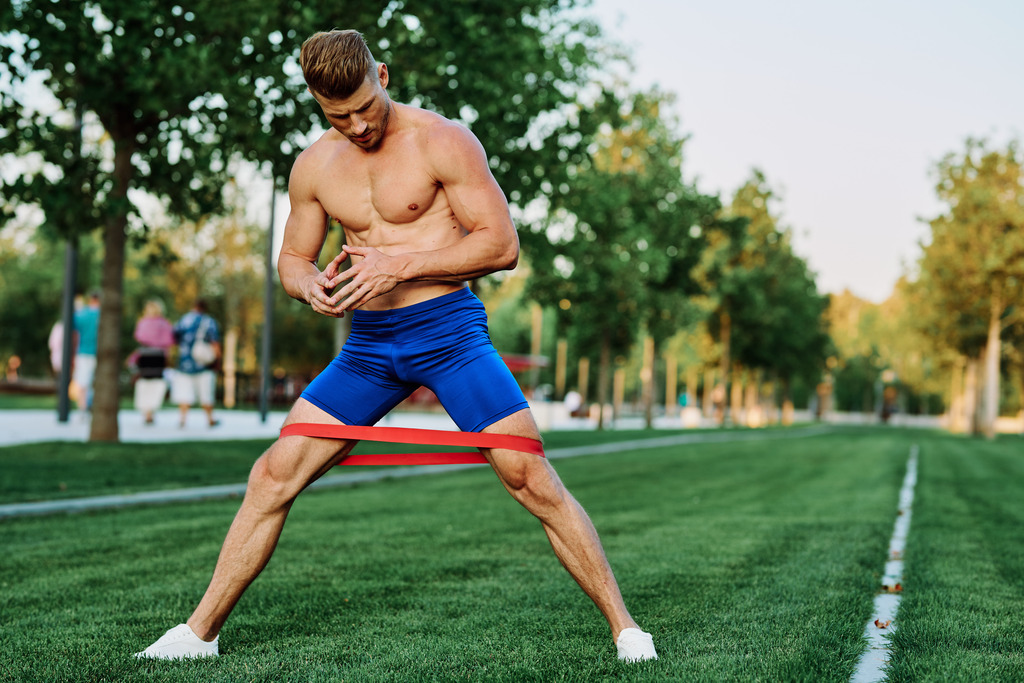Are you a soccer enthusiast looking to up your game?
It doesn’t matter if you’re a pro player or a beginner; incorporating resistance band exercises into your training routine can turn things around.
These simple yet effective tools provide targeted resistance, helping you build strength, improve flexibility, and enhance your overall performance on the field.
Let’s explore a list of resistance band exercises specifically tailored for soccer players.
It’s time to take your skills to the next level with these dynamic workouts designed to boost your agility, speed, and endurance:
Related: Best stretches for soccer players
Best Exercises For Soccer Players Using Resistance Bands
Listed below are the best resistance band workouts for soccer players:
1. Lateral Leg Raises with Resistance Band
Lateral leg raises with a resistance band are excellent for soccer players as they specifically target the hip abductors and gluteus medius.
These muscles play a crucial role in stabilizing the hips and maintaining balance during lateral movements, such as quick changes in direction and side-stepping.
Strengthening these muscles not only enhances overall lower body stability but also contributes to injury prevention by reducing the risk of strains and imbalances.
Execution:
- Attach the resistance band around your ankles.
- Stand with your feet hip-width apart.
- Lift one leg sideways against the resistance of the band, keeping the knee straight.
- Hold for a moment at the top, then lower the leg back down.
- Repeat on the other leg.
- Perform the exercise in a controlled manner, engaging your core for stability.
2. Resistance Band Shuffle Walks
Incorporating resistance band shuffle walks into a soccer training provides targeted activation of the hip abductors, quadriceps, and glutes.
The lateral movement engages muscles essential for side-to-side agility, a fundamental skill in soccer.
This exercise helps soccer players improve their defensive maneuvers, enhance lateral quickness, and develop the necessary strength for effective lateral shuffling during gameplay.
Execution:
- Place the resistance band around your ankles.
- Assume a partial squat position with your feet shoulder-width apart.
- Take small steps to the side, maintaining tension in the band.
- Keep your torso upright and engage your core throughout the movement.
- Walk laterally for a set distance or time and then reverse the direction.
3. Banded Squats
Banded squats are a key exercise for soccer players, focusing on strengthening the quadriceps, hamstrings, and glutes. These muscles are vital for explosive movements, such as sprinting, jumping, and changing direction on the field.
The resistance band adds an extra challenge, promoting better muscle engagement throughout the entire squatting motion.
By incorporating banded squats, soccer players can build lower body strength, power, and endurance, translating to improved performance during matches.
Execution:
- Position the resistance band just above your knees.
- Stand with your feet shoulder-width apart.
- Lower into a squat position while pushing your knees against the resistance of the band.
- Keep your chest up, back straight, and weight in your heels.
- Return to the starting position, fully extending your hips.
- Repeat for the recommended number of repetitions.
4. Banded Forward and Backward Running
Banded forward and backward running is an effective way for soccer players to enhance their sprinting mechanics and overall speed.
The resistance band challenges the muscles involved in both forward and backward movements, including the quadriceps, hamstrings, and hip flexors.
This resistance band workout for soccer players strengthens these muscles and improves stride length, and quickens foot turnover, contributing to increased acceleration and deceleration abilities crucial for soccer players during dynamic play.
Execution:
- Attach the resistance band around your waist, securing it to a stationary object behind you.
- Sprint forward against the resistance, driving your knees up and pumping your arms.
- After a set distance or time, switch to backward running, maintaining resistance.
- Focus on maintaining good running form and speed despite the band’s pull.
5. Side-to-Side Shuffles with Resistance Band
Side-to-side shuffles with a resistance band are particularly beneficial for soccer players looking to enhance lateral agility and quick changes of direction.
This exercise targets the hip abductors, hip adductors, and glutes, promoting stability and strength in the lateral movement plane.
Incorporating this exercise into training helps soccer players improve defensive maneuvers, respond rapidly to opponents’ movements, and reduce the risk of injuries associated with sudden changes in direction on the soccer field.
Execution:
- Place the resistance band around your ankles.
- Assume a half-squat position with your feet wider than shoulder-width apart.
- Shuffle to one side, keeping constant tension on the band.
- Maintain a low stance and quick footwork as you shuffle back and forth.
- Focus on lateral movement and control throughout the exercise.
6. Resistance Band Squat Jack
The resistance band squat jack is a dynamic and impactful exercise for soccer players, combining the benefits of squats and plyometrics.
This resistance band exercise for soccer players engages the lower body muscles, including the quads, hamstrings, and glutes, while incorporating a cardiovascular element.
The explosive nature of the squat jack helps soccer players develop power in their legs and improve cardiovascular fitness, essential for sustained high-intensity performance on the field.
Execution:
- Position the resistance band just above your knees.
- Start in a standing position with your feet together and hands at your sides.
- Jump your feet out into a wide squat position while pushing against the resistance of the band.
- Simultaneously raise your arms overhead.
- Jump back to the starting position, bringing your feet together and lowering your arms.
- Repeat the squat jack for the recommended number of repetitions.
Over To You
Incorporating resistance band exercises into your soccer training routine can help take your on-field performance to new heights.
From lateral leg raises to resisted sprints, these exercises target key muscle groups essential for soccer success.
These workouts are a versatile and effective way to enhance your strength, agility, and overall performance on the field.
Which one of them would you like to add to your routine right away?




